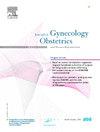Association of hyperhomocysteinemia with IVF live birth rate: A retrospective cohort study
IF 1.6
4区 医学
Q3 OBSTETRICS & GYNECOLOGY
Journal of gynecology obstetrics and human reproduction
Pub Date : 2025-09-30
DOI:10.1016/j.jogoh.2025.103044
引用次数: 0
Abstract
Objective
Homocysteine (Hcy) has been reported to be associated with female reproduction. However, the correlation between hyperhomocysteinemia (HHcy) and pregnancy outcomes among infertile women remains unclear. This observational study aims to evaluate the effect of HHcy on pregnancy outcomes in infertile patients undergoing ART treatment.
Methods
Data were collected from 385 patients (50 in the HHcy group and 335 in the non-HHcy group) who underwent In Vitro Fertilization/Intracytoplasmic Sperm Injection (IVF/ICSI) at the First Affiliated Hospital of University of Science and Technology of China. Clinical outcomes between the two groups were analyzed.
Results
The number of oocytes retrieved, MII oocytes, oocyte maturation rate and normal fertilization rate did not differ significantly between the two groups. However, the HHcy group exhibited significantly lower rates of biochemical pregnancy (48 % vs. 74.9 %), clinical pregnancy (38 % vs. 63.9 %) and live births (34 % vs. 52.8 %) in the HHcy group compared to non-HHcy group. Logistic regression analyses indicated that HHcy was negatively associated with biochemical pregnancy rate (OR= 0.28, 95 % CI: 0.14–0.54, P < 0.001), clinical pregnancy rate (OR = 0.32, 95 % CI: 0.16–0.61, P < 0.001) and live birth rate (OR = 0.45, 95 % CI: 0.23–0.86, P = 0.02).
Conclusion
HHcy exhibited a negative correlation with live birth among patients underwent IVF/ICSI. Clinicians should consider focusing more attention on patients with HHcy to enhance ART outcomes.
高同型半胱氨酸血症与IVF活产率的关联:一项回顾性队列研究。
目的:同型半胱氨酸(Hcy)已被报道与女性生殖有关。然而,高同型半胱氨酸血症(HHcy)与不孕妇女妊娠结局之间的相关性尚不清楚。本观察性研究旨在评估HHcy对接受ART治疗的不孕症患者妊娠结局的影响。方法:收集在中国科学技术大学第一附属医院接受体外受精/胞浆内单精子注射(IVF/ICSI)治疗的385例患者(HHcy组50例,非HHcy组335例)的资料。分析两组患者的临床结果。结果:两组获卵数、MII卵母细胞数、卵母细胞成熟率及正常受精率均无显著差异。然而,与非HHcy组相比,HHcy组的生化妊娠率(48% vs. 74.9%)、临床妊娠率(38% vs. 63.9%)和活产率(34% vs. 52.8%)明显低于HHcy组。Logistic回归分析显示,HHcy与生化妊娠率(OR= 0.28, 95% CI: 0.14-0.54, P < 0.001)、临床妊娠率(OR = 0.32,95% CI: 0.16-0.61, P < 0.001)、活产率(OR = 0.45,95% CI: 0.23-0.86, P = 0.02)呈负相关。结论:HHcy与IVF/ICSI患者的活产率呈负相关。临床医生应考虑将更多的注意力放在HHcy患者身上,以提高抗逆转录病毒治疗的效果。
本文章由计算机程序翻译,如有差异,请以英文原文为准。
求助全文
约1分钟内获得全文
求助全文
来源期刊

Journal of gynecology obstetrics and human reproduction
Medicine-Obstetrics and Gynecology
CiteScore
3.70
自引率
5.30%
发文量
210
审稿时长
31 days
期刊介绍:
Formerly known as Journal de Gynécologie Obstétrique et Biologie de la Reproduction, Journal of Gynecology Obstetrics and Human Reproduction is the official Academic publication of the French College of Obstetricians and Gynecologists (Collège National des Gynécologues et Obstétriciens Français / CNGOF).
J Gynecol Obstet Hum Reprod publishes monthly, in English, research papers and techniques in the fields of Gynecology, Obstetrics, Neonatology and Human Reproduction: (guest) editorials, original articles, reviews, updates, technical notes, case reports, letters to the editor and guidelines.
Original works include clinical or laboratory investigations and clinical or equipment reports. Reviews include narrative reviews, systematic reviews and meta-analyses.
 求助内容:
求助内容: 应助结果提醒方式:
应助结果提醒方式:


